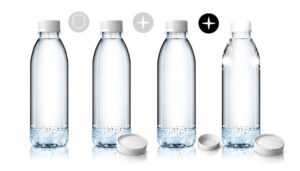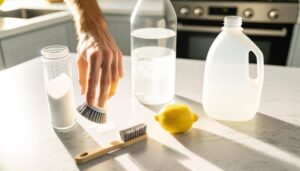How to Fix Straw in Water Bottle? Simple Solutions & Tips
To fix the straw in your water bottle, start by examining the straw for cracks and clogs. Remove the straw by unscrewing the cap and gently pulling it out.
Inspect it for kinks and straighten them if needed. Clean the straw thoroughly with a brush and mild dish soap.
Check the valve for any blockages and make sure it’s dry before reassembly. Firmly reattach the straw, secure the lid, and test for suction.
If you notice resistance or leaks, check seal integrity and replace worn parts. For further instructions on guaranteeing peak performance, continue reading the detailed steps outlined.
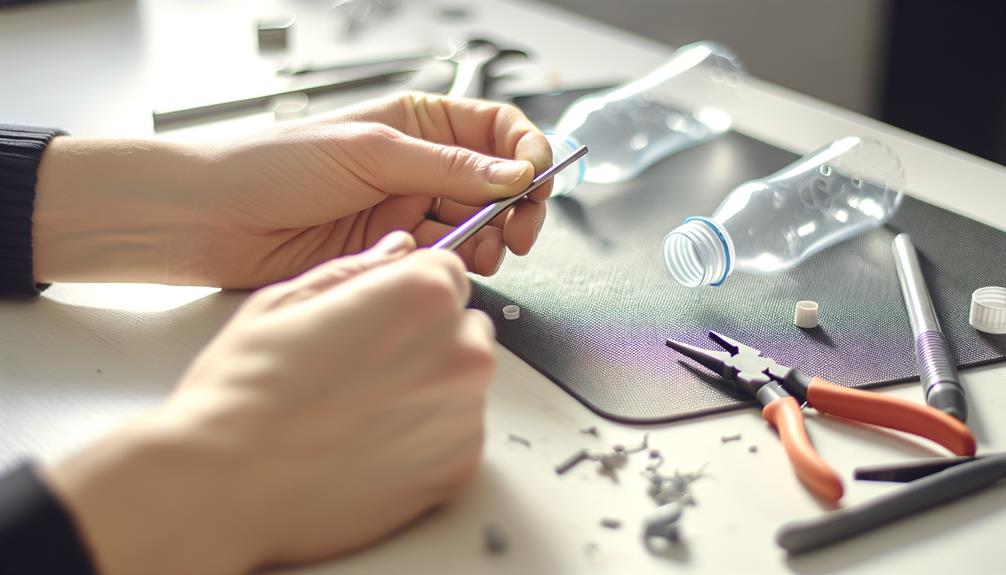
Key Takeaways
- Inspect for Damage: Check the straw for cracks, kinks, and blockages using a light source.
- Clean Thoroughly: Rinse the straw, scrub with a brush, and soak in warm soapy water to remove debris.
- Check Fitting: Ensure the straw is securely attached and properly aligned with no leaks.
- Test Suction: Sip through the straw to confirm no blockages and proper seal.
Identify the Problem
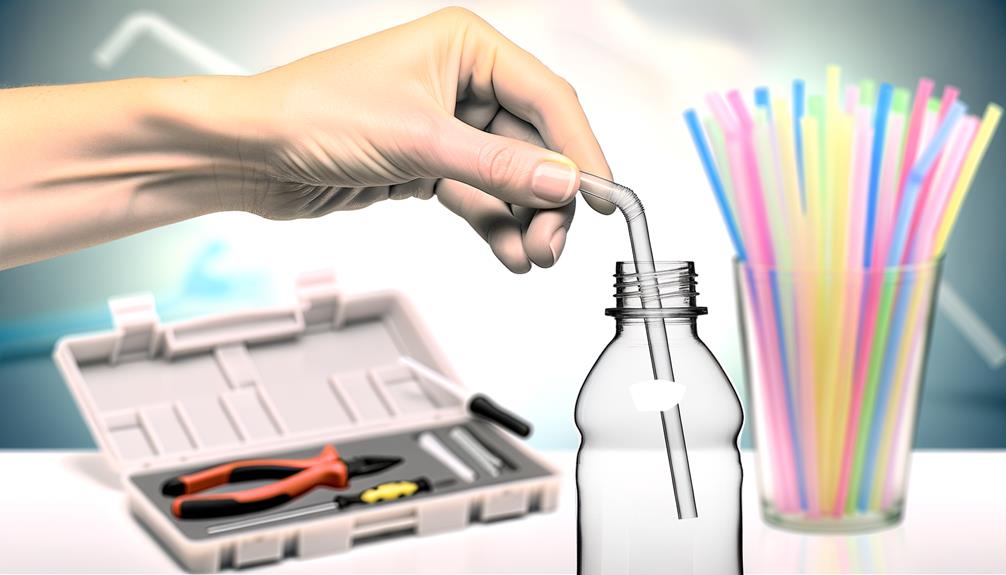
First, you need to determine whether the straw is clogged, cracked, or improperly fitted.
Start by examining the straw closely for any visible cracks. Hold it against a light source to confirm you don’t miss any tiny fractures.
Next, check if the straw is clogged. Blow through it gently and feel for any resistance. If air doesn’t pass through easily, there’s likely a blockage.
Finally, inspect how the straw fits into the bottle. Confirm it’s securely attached and not loose or misaligned. An improperly fitted straw can cause leaks or make it difficult to drink.
Remove the Straw
Once you’ve identified the issue with your straw, carefully remove it from the water bottle to begin the repair process.
Start by unscrewing the bottle’s cap, ensuring you have a firm grip. If the straw is attached to the cap, gently pull it out while maintaining a steady hand. Next, pour the powdered mix into the bottle, being careful not to spill. Add cold water until the bottle is nearly full, then securely screw the cap back on. If you’re unsure about the mixing process, you can look up instructions on how to make Kool-Aid for the perfect ratio of powder to water.
For straws that aren’t directly connected to the cap, reach inside the bottle and grasp the straw at its base. Slowly, but firmly, extract it to avoid any further damage.
Make sure to place the straw on a clean, flat surface. This methodical approach will help you prepare for the next steps in fixing the straw, ensuring no additional problems arise during the repair process.
Check for Kinks
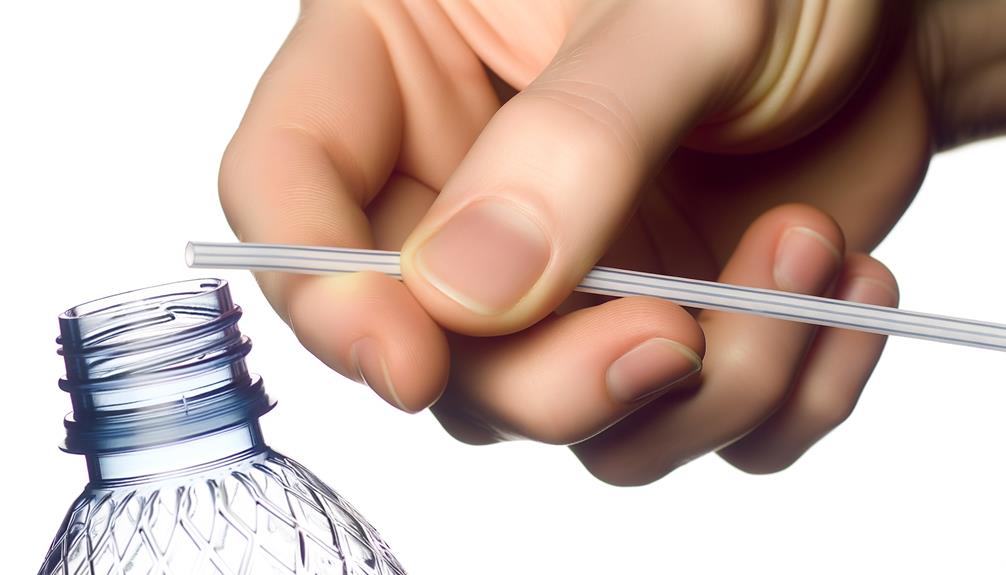
Inspect the straw thoroughly to identify any kinks or bends that could be obstructing the flow of water.
Hold the straw up to a light source and rotate it slowly, looking for any irregularities in its shape. Pay special attention to the following areas:
- Middle Section: Gently run your fingers along the length of the straw to detect any subtle bends.
- Ends of the Straw: Check the ends for any deformation that might occur from frequent use.
- Flexible Joints: If your straw has flexible sections, verify they’re not twisted or compressed.
Once you’ve identified any kinks, gently straighten them out by applying even pressure with your fingers.
Be careful not to apply too much force, as this could cause further damage.
Clean the Straw
After checking for kinks, it’s important to clean the straw thoroughly to guarantee there are no blockages affecting the water flow.
Start by removing the straw from the bottle. Rinse it under warm water to dislodge any loose debris. Next, use a straw cleaning brush, inserting it into the straw and scrubbing the interior walls. Rotate the brush to confirm all areas are cleaned. If you don’t have a brush, pipe cleaners work as an alternative.
For stubborn residue, soak the straw in a mixture of warm water and mild dish soap for 10-15 minutes. Rinse thoroughly to remove any soap.
Inspect the Valve
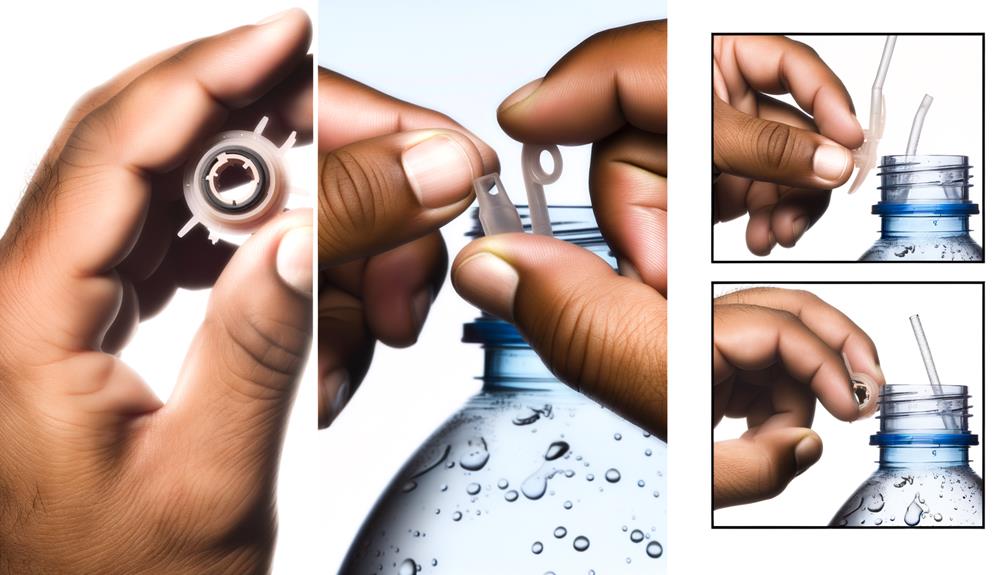
Start by carefully examining the valve for any blockages that might obstruct the flow. Use a small brush or toothpick to clear out any debris you find.
Next, verify the valve is properly aligned with the straw and securely attached.
Check for Blockages
To guarantee your water bottle’s straw functions properly, first remove the straw and closely examine the valve for any visible blockages.
You’ll want to inspect every nook and cranny where debris might accumulate. Use a flashlight if needed to spot hidden obstructions. Follow these steps systematically:
- Rinse the Valve: Run warm water through the valve to dislodge any particles. Use a gentle brush if necessary.
- Check for Residues: Look for any sticky residues that could impede water flow. If found, scrub gently with mild soap.
- Dry Thoroughly: After cleaning, affirm the valve is completely dry before reassembling to prevent mold formation.
Ensure Proper Alignment
Guaranteeing proper alignment of the valve is essential to the functionality of your water bottle’s straw.
Start by disassembling the straw and valve components. Look closely at the valve to check for any misalignment or obstructions. The valve should sit flush with its housing, and there shouldn’t be any gaps or twists.
Reattach the valve to the straw, guaranteeing it’s snug and correctly positioned. When you reassemble the water bottle, make sure the straw aligns perfectly with the valve opening.
Test by taking a few sips of water to confirm a smooth flow. If the valve is still misaligned, adjust it again until it fits perfectly.
Proper alignment guarantees a superior drinking experience.
Test for Suction
To guarantee the straw is functioning properly, start by checking for any blockages that might impede suction.
Next, make certain the straw is correctly placed and aligned within the bottle.
Check for Blockages
Start by removing the straw from the water bottle and inspecting it closely for any visible blockages. Hold it up to the light to see if there’s anything obstructing the passage.
Here’s a detailed method to guarantee thorough checking:
- Blow Through the Straw: Place one end in your mouth and blow air through it. If air passes easily, it’s clear.
- Run Water Through: Hold the straw under a faucet and let water flow through. Any blockages will prevent a steady stream.
- Use a Cleaning Brush: Insert a small brush specifically designed for cleaning straws. Push it through to dislodge any hidden debris.
Inspect Straw Placement
Once you’ve confirmed there are no blockages, it’s important to check if the straw is properly seated to guarantee efficient suction. Start by firmly pushing the straw into its designated slot. Ascertain it’s straight and not bent. Next, test for suction by taking a sip. If the flow is weak, the straw might not be fully in place. Adjust as necessary and retest.
| Step | Action |
|---|---|
| 1 | Confirm no blockages |
| 2 | Insert straw firmly |
| 3 | Ascertain straw is straight |
| 4 | Test suction by sipping |
| 5 | Adjust straw if needed |
Follow these steps methodically to ascertain the straw is seated correctly, enabling smooth water flow.
Evaluate Seal Integrity
Verifying the seal integrity is essential for effective suction, so begin by examining the connection points where the straw meets the lid and bottle. Look for any gaps, cracks, or debris that might compromise the seal.
To thoroughly test for suction:
- Fill the bottle with water: Confirm the water level is sufficient to test the suction without completely filling the bottle.
- Secure the lid tightly: Make sure the lid is firmly screwed on, and the straw is properly inserted into its designated slot.
- Test suction: Sip through the straw. If you feel resistance or hear air, the seal might be compromised.
Replace Worn Parts
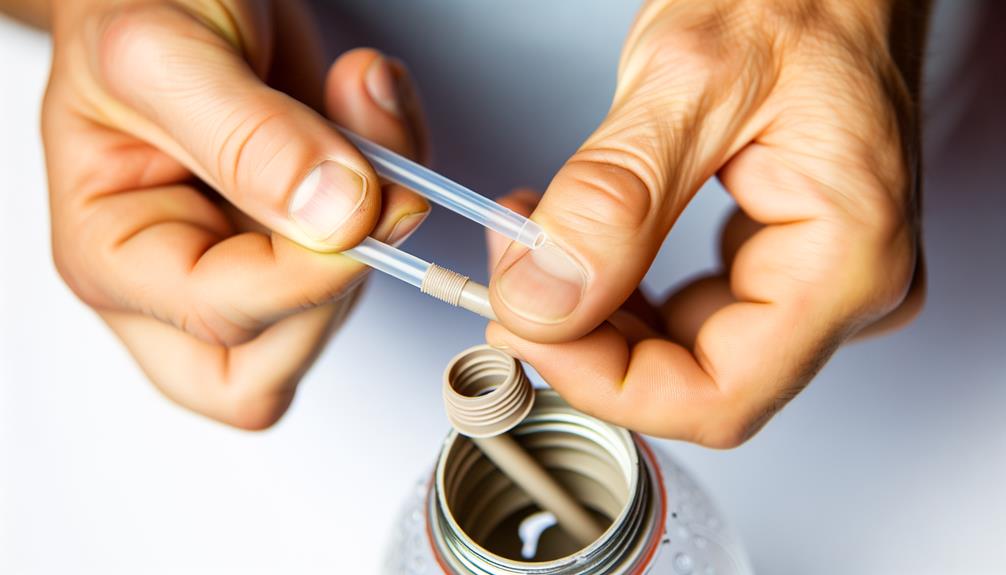
Inspect the straw and its components carefully to identify any parts that show signs of wear or damage.
Look for cracks, discoloration, or brittleness in the straw. Pay attention to the seals and gaskets; they should be flexible and free from tears or deformities.
If you find any compromised parts, replace them with new ones. Most water bottles have replacement kits available, so check the manufacturer’s website or local store.
When installing the new parts, guarantee they fit snugly and align correctly with the rest of the bottle.
Don’t forget to also check the mouthpiece for any signs of wear and replace it if needed.
This guarantees your water bottle remains functional and hygienic.
Reassemble the Bottle
Carefully align the straw with its designated slot in the bottle, guaranteeing it sits firmly in place.
Make sure there’s no wiggle room, as a loose straw can cause leaks or drinking difficulties. Next, secure the lid tightly to prevent any spills.
Follow these steps:
- Insert the Straw: Push the straw into its slot until you feel it click or fit snugly.
- Attach the Lid: Twist the lid onto the bottle, guaranteeing it’s threaded correctly.
- Check for Leaks: Fill the bottle with water and test for any leaks by tilting and shaking it gently.
Taking these meticulous steps confirms that your water bottle functions effectively, providing a reliable drinking experience.
Your attention to detail guarantees durability and efficiency.
Prevent Future Issues
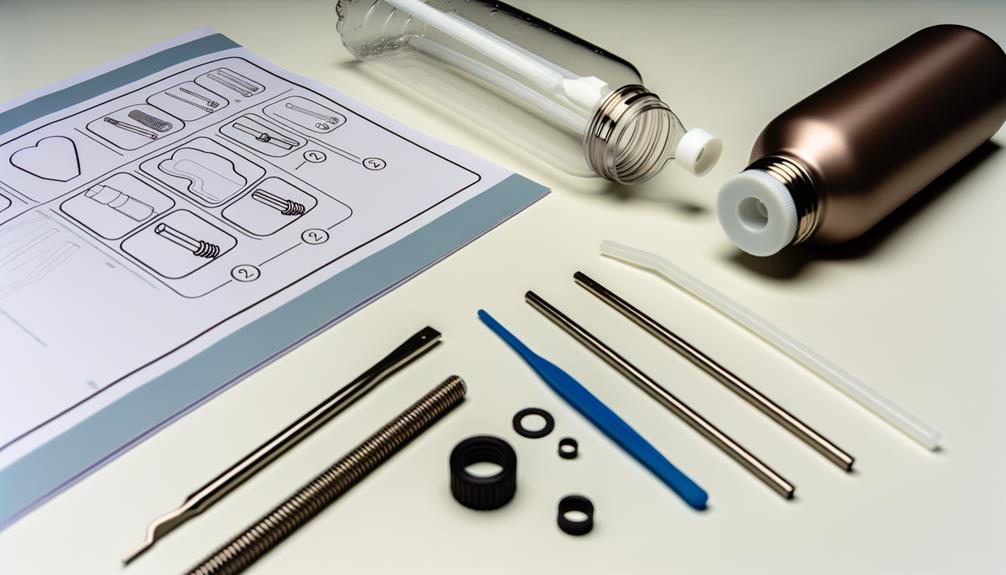
To avoid future problems with your water bottle’s straw, regularly clean all components and inspect for wear and tear. Disassemble the bottle weekly and use a brush to clean the straw’s interior. Check for cracks or loose parts that might cause leaks. Always dry thoroughly after cleaning to prevent mold.
| Step | Action |
|---|---|
| 1. | Disassemble all components |
| 2. | Clean straw thoroughly |
| 3. | Inspect for cracks and wear |
| 4. | Dry all parts completely |
| 5. | Reassemble and test for leaks |
Conclusion
You’ve now transformed frustration into satisfaction by methodically diagnosing and fixing your water bottle’s straw.
From identifying the problem to reassembling the bottle, each step was a meticulous journey towards a simple, yet significant, victory.
Remember, what was once a source of annoyance is now a proof of your ability to troubleshoot and resolve.
Keep this experience in mind, and you’ll prevent future issues with ease, ensuring your hydration routine remains uninterrupted.




